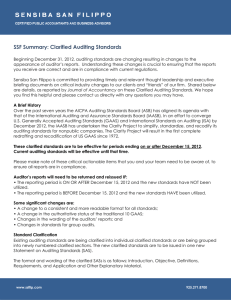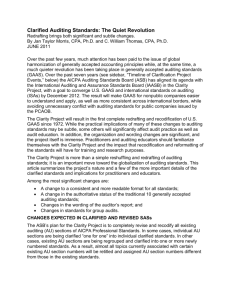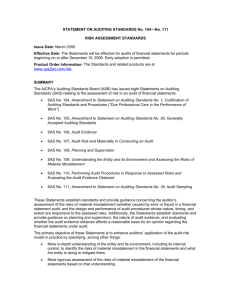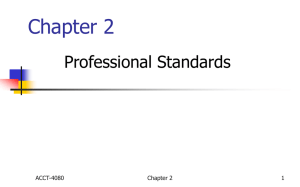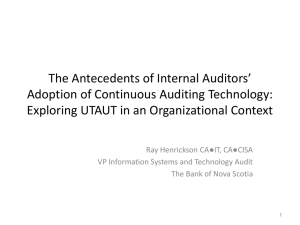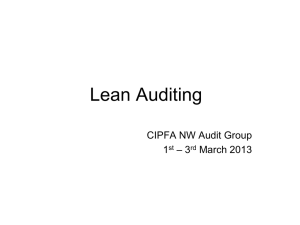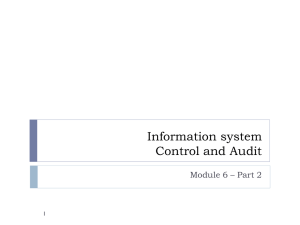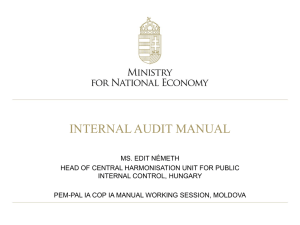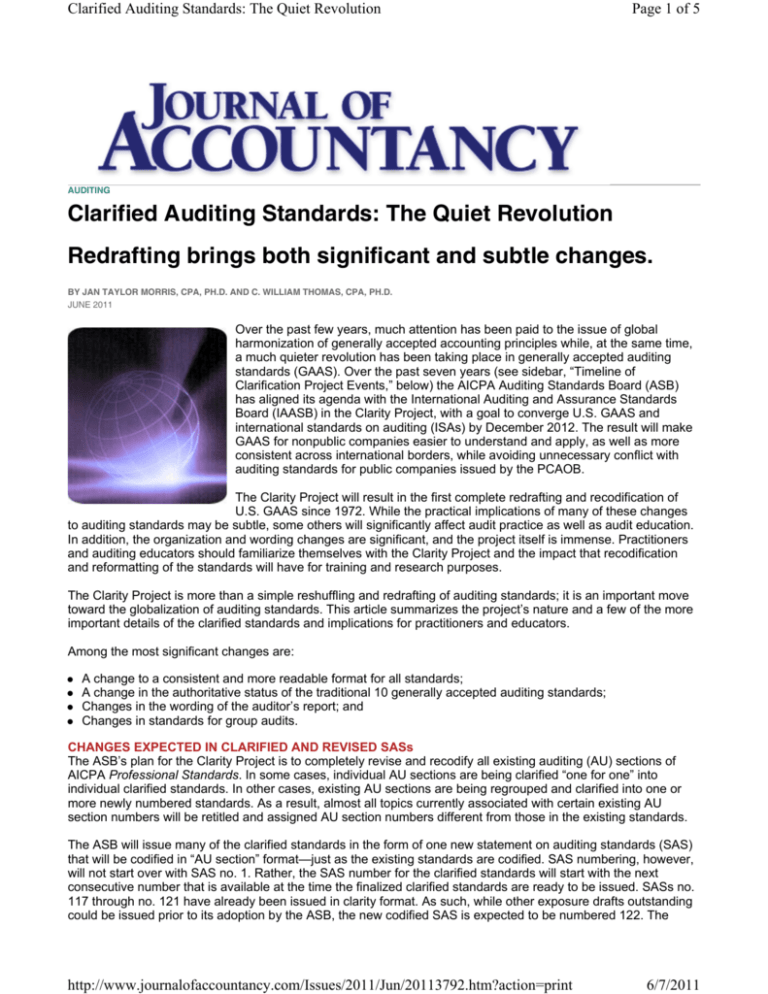
Clarified Auditing Standards: The Quiet Revolution
Page 1 of 5
AUDITING
Clarified Auditing Standards: The Quiet Revolution
Redrafting brings both significant and subtle changes.
BY JAN TAYLOR MORRIS, CPA, PH.D. AND C. WILLIAM THOMAS, CPA, PH.D.
JUNE 2011
Over the past few years, much attention has been paid to the issue of global
harmonization of generally accepted accounting principles while, at the same time,
a much quieter revolution has been taking place in generally accepted auditing
standards (GAAS). Over the past seven years (see sidebar, “Timeline of
Clarification Project Events,” below) the AICPA Auditing Standards Board (ASB)
has aligned its agenda with the International Auditing and Assurance Standards
Board (IAASB) in the Clarity Project, with a goal to converge U.S. GAAS and
international standards on auditing (ISAs) by December 2012. The result will make
GAAS for nonpublic companies easier to understand and apply, as well as more
consistent across international borders, while avoiding unnecessary conflict with
auditing standards for public companies issued by the PCAOB.
The Clarity Project will result in the first complete redrafting and recodification of
U.S. GAAS since 1972. While the practical implications of many of these changes
to auditing standards may be subtle, some others will significantly affect audit practice as well as audit education.
In addition, the organization and wording changes are significant, and the project itself is immense. Practitioners
and auditing educators should familiarize themselves with the Clarity Project and the impact that recodification
and reformatting of the standards will have for training and research purposes.
The Clarity Project is more than a simple reshuffling and redrafting of auditing standards; it is an important move
toward the globalization of auditing standards. This article summarizes the project’s nature and a few of the more
important details of the clarified standards and implications for practitioners and educators.
Among the most significant changes are:
A change to a consistent and more readable format for all standards;
A change in the authoritative status of the traditional 10 generally accepted auditing standards;
Changes in the wording of the auditor’s report; and
Changes in standards for group audits.
CHANGES EXPECTED IN CLARIFIED AND REVISED SASs
The ASB’s plan for the Clarity Project is to completely revise and recodify all existing auditing (AU) sections of
AICPA Professional Standards. In some cases, individual AU sections are being clarified “one for one” into
individual clarified standards. In other cases, existing AU sections are being regrouped and clarified into one or
more newly numbered standards. As a result, almost all topics currently associated with certain existing AU
section numbers will be retitled and assigned AU section numbers different from those in the existing standards.
The ASB will issue many of the clarified standards in the form of one new statement on auditing standards (SAS)
that will be codified in “AU section” format—just as the existing standards are codified. SAS numbering, however,
will not start over with SAS no. 1. Rather, the SAS number for the clarified standards will start with the next
consecutive number that is available at the time the finalized clarified standards are ready to be issued. SASs no.
117 through no. 121 have already been issued in clarity format. As such, while other exposure drafts outstanding
could be issued prior to its adoption by the ASB, the new codified SAS is expected to be numbered 122. The
http://www.journalofaccountancy.com/Issues/2011/Jun/20113792.htm?action=print
6/7/2011
Clarified Auditing Standards: The Quiet Revolution
Page 2 of 5
codified SAS is scheduled to be effective for periods ending on or after Dec. 15, 2012, and current auditing
standards will be effective until that time.
Exhibit 1 lists selected proposed changes to SASs based on current practices. This article reviews a few of the
more significant changes.
FORMAT OF NEW SASs
The most obvious changes resulting from the Clarity Project will be the required format and wording of the
standards. The typical format in a clarified SAS follows:
Introduction. The “Introduction” describes the scope of the standard, provides essential material for
understanding the nature of the standard, and notes the effective date. The ASB decided to make the effective
date for future clarified standards “for periods ending on or after” rather than “for periods beginning on or after.”
This will ensure that the redrafted standards are not effective for audits of financial statements for periods that are
shorter than 12 months in the first year the clarified SASs are effective.
Objective. According to the AICPA, the foundation of the Clarity Project is the establishment of an objective for
each auditing standard in order to better reflect a principles-based approach to standard setting. The “Objective”
section provides the context for the requirements, providing the overall purpose for the requirements and
establishing a framework for the application of judgment by the auditor in interpreting the standard.
Definitions. The “Definitions” section defines any terms or expressions that are being introduced in a standard for
the first time. For instance, in the Definitions section of SAS no. 120, the phrase “applicable financial reporting
framework” is introduced. The ASB is drafting the revised standards with the viewpoint that these standards are
neutral about the financial reporting framework used in the financial statements. This viewpoint allows for the
possibility that the financial statements being audited have been prepared in accordance with frameworks other
than GAAP (for example, IFRS).
Requirements. “Requirements” will be presented as unconditional (indicated by must) or presumptively
mandatory (indicated by should). Most requirements will be expressed as a should, meaning that the auditor is
required to comply with the requirement, but, in rare circumstances, may depart from the requirement by
performing alternative audit procedures to achieve the intent of the requirement, provided that the auditor
document justification for the departure. Requirements presented as a must need to be followed without
departure.
Application and Other Explanatory Material. The “Application and Other Explanatory Material” section is
indicated by applying an “A” prefix to the applicable paragraph number. This section of the standard uses the term
may when providing examples and other explanatory information. It is important to note that the Application and
Other Explanatory Material section is an integral part of the standard, and auditors are required to have an
understanding of this section. This section also includes special considerations for audits of governmental entities
and for audits of smaller, less complex organizations. Each finalized standard may also include an exhibit that
notes any substantive differences with the applicable ISA.
CHANGE IN STATUS FOR GAAS
One of the most basic changes being made in the clarified standards is the status of the 10 basic rules
traditionally known as the generally accepted auditing standards (GAAS) contained in current AU section 150.
Auditors have traditionally classified these 10 standards into three groups: general, fieldwork and reporting.
Through the Clarity Project, the requirements included in the 10 standards have been incorporated into various
clarified standards. To provide a framework that is helpful in understanding and explaining an audit, the 10
standards will form the basis for “clarified principles” that, while still broadly applicable, will not carry any authority
but rather provide a framework that is helpful in understanding and explaining an audit. These clarified principles
are presented in the Preface of the clarified standards, included with the clarified SAS, Overall Objectives of the
Independent Auditor and the Conduct of an Audit in Accordance with GAAS.
CHANGES IN THE AUDITOR’S REPORT
The clarified SAS, Forming an Opinion and Reporting on Financial Statements, along with the clarified SAS,
Modification to the Opinion in the Independent Auditor’s Report, and the clarified SAS, Emphasis-of-Matter
Paragraphs and Other-Matter Paragraphs in the Independent Auditor’s Report, will, in combination, supersede
prior auditing standards associated with the auditor’s reports for financial statement audits, including most of AU
section 508, Reports on Audited Financial Statements. The primary changes, once again, pertain more to the
http://www.journalofaccountancy.com/Issues/2011/Jun/20113792.htm?action=print
6/7/2011
Clarified Auditing Standards: The Quiet Revolution
Page 3 of 5
appearance and presentation of the report than to the substance that supports the auditor’s report. However, the
changes to the report format are significant, including the following:
The introduction paragraph will no longer have a reference to either management’s or the auditor’s
responsibility.
A new section of the report will be required with the heading “Management’s Responsibility for the Financial
Statements.” This section will describe management’s responsibility for the preparation and fair presentation of
the financial statements and will reference management’s responsibility for the design, implementation and
maintenance of internal control relevant to the preparation and fair presentation of the financial statements that
are free from material misstatement, whether due to error or fraud.
Another new section of the report, requiring the heading “Auditor’s Responsibility,” will include a statement
related to the auditor’s responsibility to express an opinion on the financial statements based on the audit. This
section essentially replaces the “scope” paragraph and will also include a statement that the audit was
conducted in accordance with generally accepted auditing standards in the United States (or other standards
and country of origin, if applicable).
The opinion paragraph will be preceded by the heading “Opinion,” clearly differentiating the opinion from the
report. No other changes have been made to the unqualified opinion paragraph. When the auditor issues an
opinion other than unqualified, the paragraph detailing the reason for the modified report is still required
immediately preceding the opinion paragraph, but now must have an appropriate heading: “Basis for Qualified
Opinion,” “Basis for Adverse Opinion,” or “Basis for Disclaimer of Opinion.” U.S. standards will differ from ISAs
as an explanation-of-matter (EOM) paragraph for an unqualified opinion will continue to be required whenever
there is an inconsistency.
Additional guidance is provided and requirements added when the auditor has other reporting responsibilities,
such as reporting on legal or regulatory requirements. Signature and date of the report will remain essentially the
same as under current auditing standards.
CHANGES IN STANDARDS FOR GROUP AUDITS
One primary change that has been affected by the globalization effort is the introduction of the “Group Audit”
standard, based on ISA 600 (revised), The Work of Related Auditors and Other Auditors in the Audit of Group
Financial Statements. U.S. standards include only limited guidance in this area (SAS no. 1, section 543, Part of
Audit Performed by Other Independent Auditors).
The clarified SAS, Special Considerations—Audits of Group Financial Statements (Including the Work of
Component Auditors), will likely create significant changes in the scoping of multilocation audits. The
requirements of the clarified SAS will require multioffice audit firms with two or more offices involved in an
engagement to audit group financial statements to consider, among other things, the group engagement team’s
process to assess risk and the determination of materiality to be used to audit the group financial statements and
materiality to be used to audit components.
IMPACT ON STANDARDS FOR PUBLIC COMPANIES
While the PCAOB has remained silent on the issue, the globalization of auditing standards by the ASB might be
viewed as a precursor to the same type of project by the PCAOB. What impact might the Clarity Project have on
standards for public companies, for which the PCAOB has sole authority?
In 2003, the PCAOB adopted existing U.S. GAAS as interim standards, subject to periodic revision as the board
deemed necessary. Since that time, the PCAOB has issued its own auditing standards in areas of the audit in
which differentiated audit procedures or reporting requirements have been considered necessary. These areas
largely pertain to audits of internal control over financial reporting as well as reports on those controls, audit
documentation and engagement quality review.
The PCAOB’s Office of the Chief Auditor has developed its own agenda for revisions of auditing standards
applicable to issuers, based on its independent analysis of the continuing applicability of existing interim
standards, as well as results of PCAOB inspections, and recent economic developments such as the downturn in
financial markets caused by the banking crisis of 2008. The PCAOB has not yet announced any changes
resulting from the ASB’s Clarity Project. However, we think it is likely that the PCAOB will amend its standards in
accordance with its stated policy for ongoing revisions to ensure that they are current and in step with existing
best practices.
http://www.journalofaccountancy.com/Issues/2011/Jun/20113792.htm?action=print
6/7/2011
Clarified Auditing Standards: The Quiet Revolution
Page 4 of 5
Timeline of Clarification Project Events
2002: Passage of Sarbanes-Oxley Act.
2003: The IAASB begins work on Clarity Project.
2004: The ASB aligns agenda with the IAASB and begins work on Convergence Plan.
2006: The IAASB establishes conventions for drafting clarified standards and begins redrafting process.
2007 (March): The ASB issues discussion paper on Clarity Project.
2008 (April): The ASB issues exposure draft of first clarified standard.
2008 (December): The IAASB completes Clarity Project.
2009 (December): Clarified ISAs go into effect.
2011 (expected October): ASB completes Clarity Project.
2012 (expected): Clarified SASs become effective for periods ending on or after Dec. 15, 2012.
EXECUTIVE SUMMARY
Since 2004, the AICPA’s Auditing Standards Board (ASB) has aligned its agenda with that of the
International Auditing and Assurance Standards Board. Each group has undertaken a project to simplify,
standardize and recodify its auditing standards to be easier to understand and more consistently applicable on a
global basis.
The ASB will complete its Clarity Project in 2011, and its new standards are expected to be effective for
periods ending on or after Dec. 15, 2012.
The Clarity Project will result in the first complete recodification of U.S. GAAS since 1972. The new revised
format for all existing auditing (AU) sections of AICPA Professional Standards includes an introduction, objective,
definitions, requirements, and application and other explanatory material.
Wording will be clearer, easier to understand, and consistent across international borders.
Some existing AU sections will be redrafted “one for one,” while others will be regrouped and clarified
into one or more newly numbered standards.
Among the more substantive changes will be the change in status of the 10 generally accepted auditing
standards, the wording of the auditor’s standard report and standards for group audits.
Jan Taylor Morris (jtm017@shsu.edu) is an assistant professor of accounting at Sam Houston State University.
C. William Thomas (bill_thomas@baylor.edu) is the KPMG/Holton Chair and J.E. Bush Professor of Accounting
at Baylor University.
To comment on this article or to suggest an idea for another article, contact Kim Nilsen, editorial director, at
knilsen@aicpa.org or 919-402-4048.
AICPA RESOURCES
Publications
The AICPA Audit Committee Toolkit (#991006)
The AICPA Audit Committee Toolkit: Not-for-Profit Organizations (#991010)
CPE self-study
Auditing Update: A Review of Recent Activities (#732776)
Conferences
National Advanced Accounting and Auditing Technical Symposium, July 14–15, 2011, Las Vegas
National Governmental Accounting and Auditing Update East, Aug. 22–23, 2011, Washington
National Governmental Accounting and Auditing Update West, Sept. 19–20, 2011, Las Vegas
National Governmental and Not-for-Profit Training Program, Oct. 24–26, 2011, Lake Buena Vista (Orlando),
Fla.
http://www.journalofaccountancy.com/Issues/2011/Jun/20113792.htm?action=print
6/7/2011
Clarified Auditing Standards: The Quiet Revolution
Page 5 of 5
For more information or to make a purchase or register, go to cpa2biz.com or call the Institute at 888-777-7077.
Websites
Improving the Clarity of ASB Standards, which includes links to the following resources: “Mapping of Existing
AU Sections to Clarity Statements on Auditing Standards”; “Clarity Project: Questions and Answers”; and “Final
Clarified Statements on Auditing Standards,” tinyurl.com/6xvg8zt
Summary of Changes in Requirements from Statements on Auditing Standards (SASs) No. 1 through No. 120
to Clarified SASs, tinyurl.com/66que3t
More from the JofA:
Find us on Facebook | Follow us on Twitter | View JofA videos
Copyright © 2011 American Institute of Certified Public Accountants. All rights reserved.
http://www.journalofaccountancy.com/Issues/2011/Jun/20113792.htm?action=print
6/7/2011

